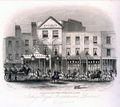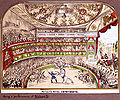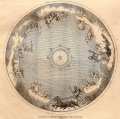Astley's Amphitheatre
From Circopedia
The World's First Circus
Astley's Amphitheatre, located on Westminster Road in Lambeth, London, was opened in 1768 by Philip Astley (1742-1814), the creator of modern circus. It was the very first circus—although it never held that name, which was coined by Astley's first competitors, Charles Hughes (1747–1797) and Charles Dibdin (1745-1814), who opened their Royal Circus—the first circus by that name—on November 4, 1782, on Blackfriars Road, near the junction of the thoroughfares leading to Westminster, Blackfriars and London bridges, known today as St. George’s Circus.
Astley's Amphitheatre, which was originally an open-air arena, was a London's landmark for 125 years, from 1768 through 1893; it was rebuilt several times (and was destroyed by fire three times, in 1794, 1801, and 1825). Over the years, it also changed its name and its owners, starting with Astley's Riding School (1768-1780), then Astley's Riding House (1780-1782), Astley's Amphitheatre (1782-1790), The Royal Grove (1791-1794), and Astley's Amphitheatre of Arts (1795-1801), during which years it was owned and managed by Philip Astley; then it became the Royal Amphitheatre of Arts (1795-1801), still under Philip Astley until 1814, then under his son, John Astley (1767-1821).
Upon John Astley's death in 1821, it passed under the ownership of the equestrian William Davis under the title Davis' Royal Amphitheatre, which it kept from 1821 to 1825. Then Davis leased it to the star equestrian Andrew Ducrow (1793-1842), who renamed it Royal Amphitheatre (1825-1841); by then, the circus was simply called "Astley's" by its audiences. Nonetheless, after the 1825 fire and the subsequent death of Ducrow, it became Batty's Amphitheatre under the management of a new owner, William Batty (1801-1868), who managed it from 1842 to 1862. It resumed its true identity (Astley's Amphitheatre) when Batty leased it for seven years, from 1853 to 1860 to the Scottish circus entrepreneur William Cooke (1851-1905), who had difficulties keeping the circus afloat. Eventually, Cooke regained enough control on his finances to remain there until 1862.
In 1863-1864, it became the New Westminster Theatre when it was leased to the Irish playwright Dion Boucicault (1820-1890), who boarded the ring floor to install stalls. This experience proved a disaster, and in 1864, the British impresario Edward Tyrrell Smith (1804–1877) took over and revived Astley's Amphitheatre with the American sensation Adah Isaacs Menken (1835-1868) in a reprise(French) Short piece performed by clowns between acts during prop changes or equipment rigging. (See also: Carpet Clown) of her greatest (and only) success, the hippodramaEquestrian pantomime, often with a military subject matter, very popular in mid-nineteenth-century urban circuses. Mazeppa. Smith remained the lessee from 1864 to 1873, alternating hippodramas and Bristish pantomimes (pantos). Finally, in 1873, Batty's widow sold the circus to the legendary circus director "Lord" George Sanger (1825-1911), who ran it as a bona fide circus until 1893, when, sadly, the world's first circus was demolished.
(NOTE: This is a preliminary article, which will be expanded in the future)
Suggested Reading
- Maurice Willson Disher, Greatest Show on Earth (London, G. Bell & Sons Ltd., 1937)
See Also
- Biographies: Philip Astley, John Astley, Andrew Ducrow, William Batty, "Lord" George Sanger


















